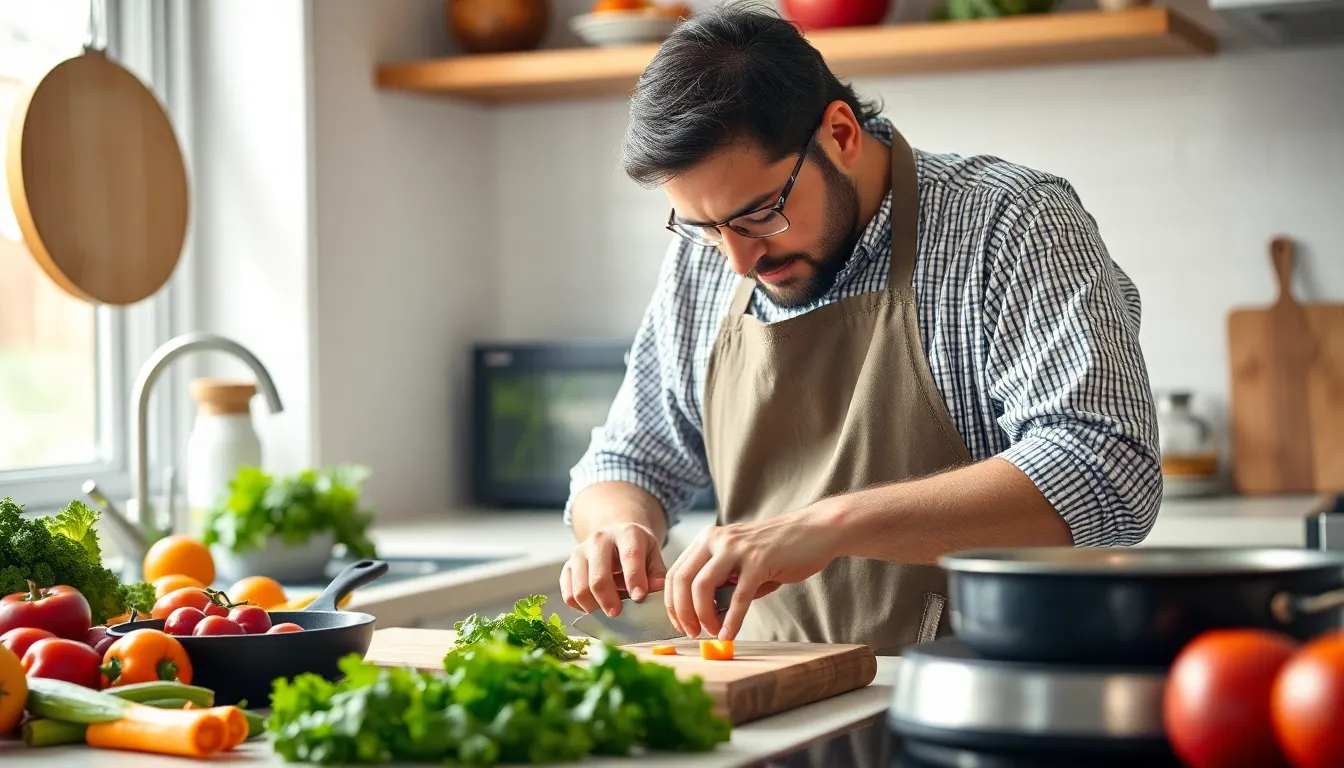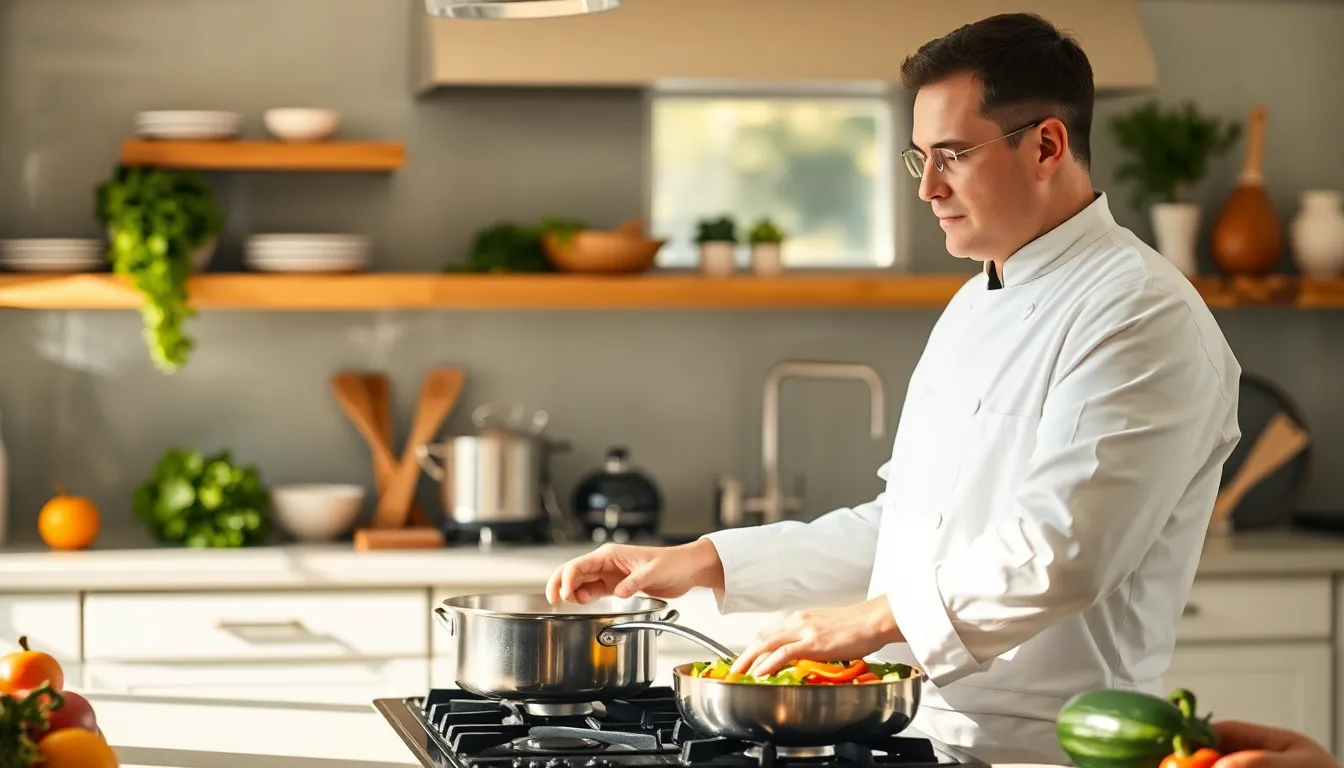In the world of cooking, mastering culinary techniques can feel like unlocking a secret level in a video game. Suddenly, the humble home cook transforms into a kitchen wizard, conjuring up delicious dishes that leave friends and family begging for more. From sautéing to sous-vide, these skills are the magic wands of the culinary realm, turning ordinary ingredients into extraordinary meals.
Culinary Techniques
Culinary techniques encompass various methods and skills essential for creating delicious and visually appealing dishes. Mastering these techniques allows cooks to elevate their culinary creations. Sautéing is one such essential technique that involves cooking food quickly in a small amount of fat over high heat, producing flavorsome results.
Braising stands out as another vital method. This technique combines both dry and moist cooking, typically beginning with searing food in fat followed by slow cooking in liquid. Braising tenderizes tougher cuts of meat, making them flavorful and juicy.
Grilling provides another option, characterized by cooking food over direct heat. This technique imparts a smoky flavor, enhancing the overall taste profile of meats and vegetables. Baking, often used for pastries and bread, employs dry heat in an oven, resulting in even cooking and delightful textures.
Sous-vide is a modern technique that connects cooks to precision. Vacuum-sealing food in bags and cooking it submerged in water at controlled temperatures enhances flavors while ensuring even doneness. Poaching, on the other hand, involves cooking food gently in simmering liquid, offering a healthier alternative that preserves moisture and flavor.
Roasting brings a different approach, applied to various foods such as meats or vegetables. This technique uses dry heat in an oven, creating a crispy outer layer while maintaining juiciness inside. Steaming, recognized for being a healthy cooking method, retains nutrients by cooking food through hot steam, often preferred for vegetables and fish.
Incorporating these techniques enriches the home cook’s repertoire, ensuring they can craft impressive meals with confidence.
Essential Culinary Techniques

Mastering essential culinary techniques significantly enhances cooking skills. Various methods allow home cooks to elevate their dishes.
Knife Skills
Knife skills serve as the foundation of efficient cooking. Proper techniques include chopping, slicing, and dicing ingredients, which ensures consistency in cooking times. The use of a sharp knife reduces the risk of accidents and improves precision. Familiarity with different knife types, such as chef’s knives and paring knives, enhances versatility in the kitchen. Regular practice of these skills leads to faster meal prep, enabling cooks to manage multiple components. Taking time to learn proper handling and maintenance of knives increases safety and longevity.
Cooking Methods
Cooking methods transform raw ingredients into flavorful dishes. Sautéing involves high heat and fat, perfect for quick cooking while retaining nutrients. Braising combines dry heat and moisture to tenderize tougher meats, creating delicious contrasts in flavor. Grilling introduces a distinct smoky taste, while roasting provides an even cooking experience with caramelization. Baking offers controlled temperatures for pastries and bread, enhancing texture. Sous-vide utilizes water baths for precise temperature control, ensuring perfectly cooked foods. Each method provides unique benefits that enrich culinary creations.
Advanced Culinary Techniques
Mastering advanced culinary techniques transforms cooking from routine to art. These methods enhance flavors and presentation, elevating home cooking.
Sous Vide Cooking
Sous vide cooking involves vacuum-sealing food and cooking it at precise temperatures in a water bath. This method ensures even heat distribution, resulting in perfect texture and tenderness. Chefs often use sous vide to maintain moisture in proteins while infusing flavors. The technique proves beneficial for meats, vegetables, and even eggs, providing consistent results across multiple servings. Many also appreciate how sous vide simplifies meal preparation, allowing for accurate cooking without active supervision.
Molecular Gastronomy
Molecular gastronomy incorporates scientific principles into cooking. This innovative approach alters food texture and flavor through techniques like spherification and gelification. Chefs frequently create surprising dishes, such as caviar-like pearls from fruit juices or foams from infused liquids. Experimentation defines this style, encouraging culinary artists to push boundaries in presentation and taste. Additionally, molecular gastronomy enhances dining experiences, turning meals into multisensory adventures. Chefs embracing this technique often engage diners with unexpected flavors and textures, transforming traditional meals into extraordinary culinary feats.
Regional Culinary Techniques
Mastering regional culinary techniques enhances the cooking experience, allowing cooks to explore diverse flavors and traditions. Different regions offer unique methods that elevate dishes worldwide.
Mediterranean Techniques
Mediterranean cuisine emphasizes fresh ingredients and simple techniques. Grilling showcases the region’s approach, bringing out the natural flavors of meats, vegetables, and fish. Roasting often complements Mediterranean dishes, creating aromatic profiles through herbs and spices. Fermentation adds depth, seen in dishes like tzatziki made from yogurt and cucumbers. Braising provides tender textures in commonly used stews, while sautéing enhances quick meals featuring seasonal produce.
Asian Cooking Methods
Asian cooking methods include specific techniques central to various cultures. Stir-frying involves high heat for quick cooking, preserving the crunch of vegetables and the tenderness of proteins. Steaming is prevalent, retaining moisture and nutrients in fish or dumplings. Wok cooking is a traditional method that provides versatility, allowing chefs to create dishes with bold flavors quickly. Braising also plays a key role, especially in Chinese cuisine, where rich, hearty dishes emerge from this slow-cooked process. Additionally, pickling offers a way to enhance flavor while extending ingredient shelf life.
Conclusion
Mastering culinary techniques opens up a world of possibilities in the kitchen. With each method learned, home cooks can elevate their dishes and impress their guests. Whether it’s the precision of sous-vide or the bold flavors from grilling, these skills foster creativity and confidence.
Incorporating regional techniques allows cooks to explore diverse culinary traditions, enriching their meals with unique flavors. The journey of mastering these techniques not only enhances cooking but also transforms the cooking experience into an art form. Embracing these methods can lead to a deeper appreciation for food and the joy of sharing it with others.

